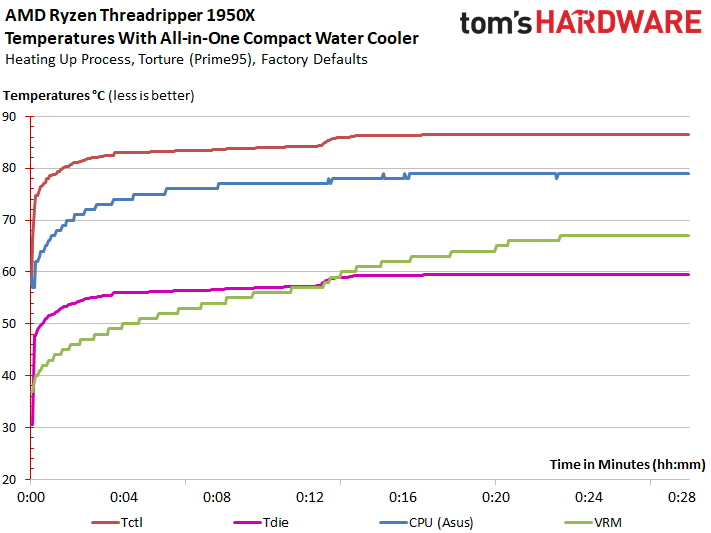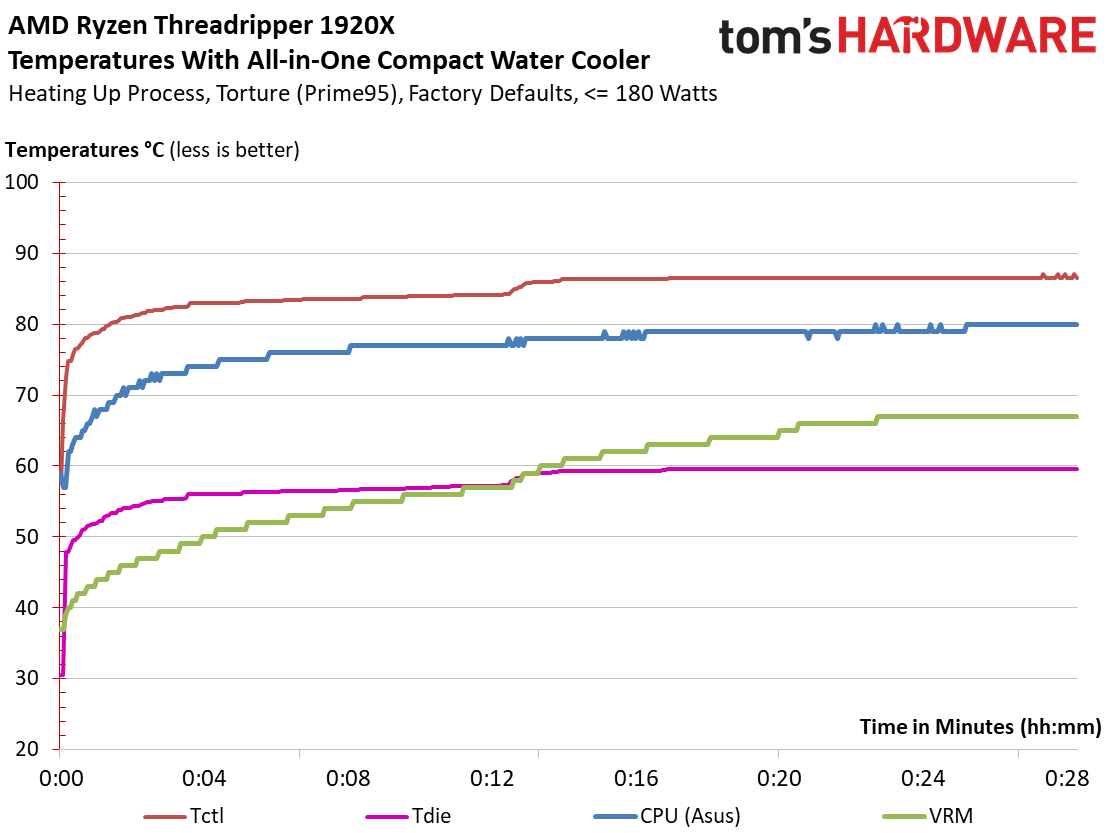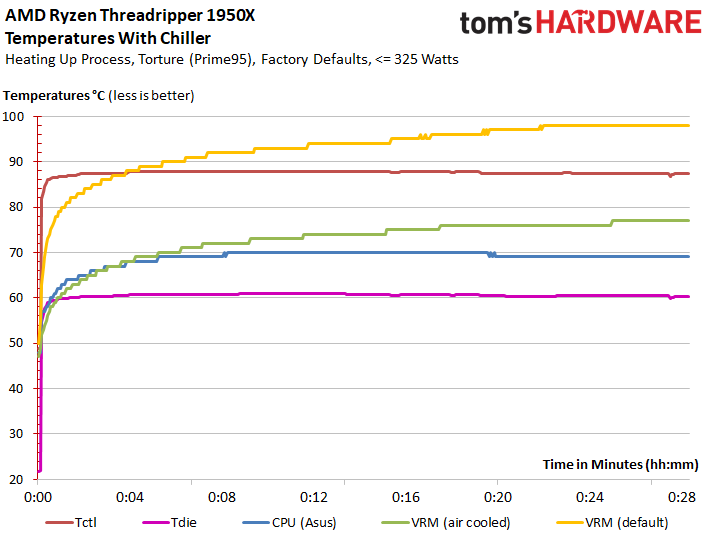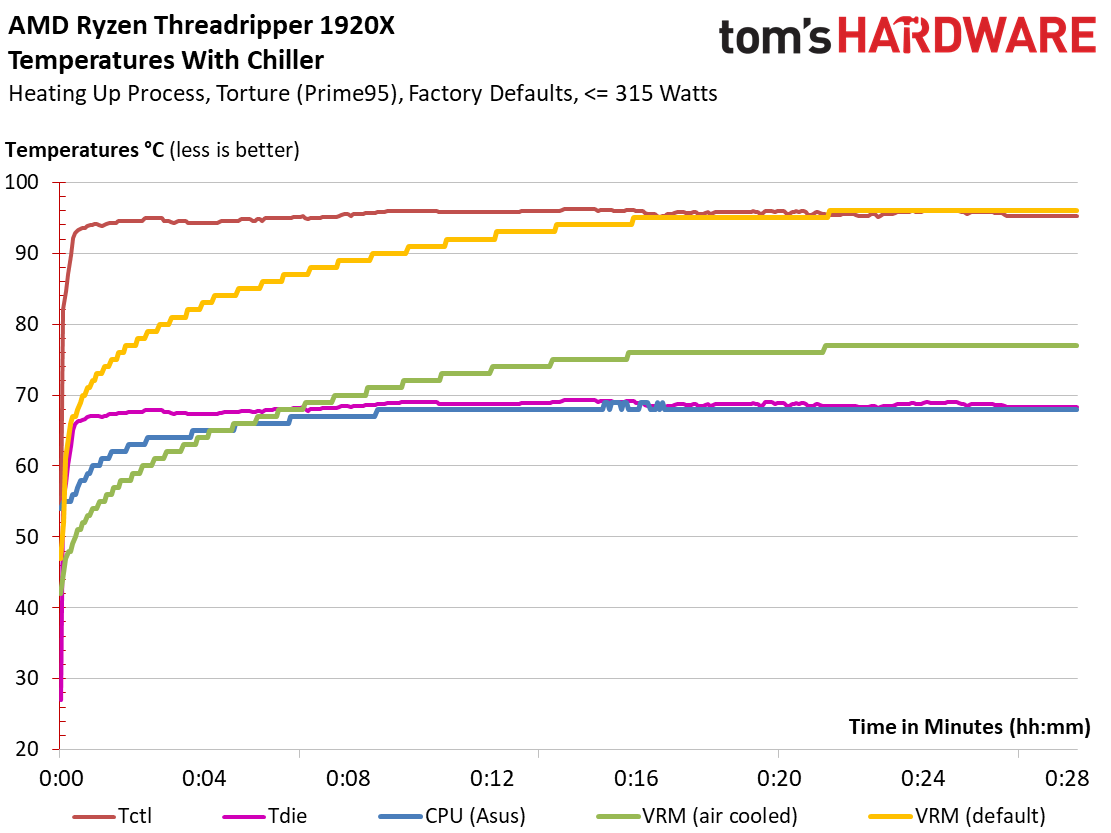AMD Ryzen Threadripper 1920X Review
Why you can trust Tom's Hardware
Overclocking, Cooling & Temperature
The Right Cooling Solution
AMD uses solder between Threadripper's dies and its heat spreader. This plays a critical role in aiding our overclocking efforts, helping us achieve the highest clock rate we've seen from a Ryzen CPU. We made significant changes to our cooling setup to avoid a few issues with the standard mounting mechanism.
Overclocking
Our Threadripper 1950X sample overclocked to 3.9 GHz at 1.35V, and the 1920X hit 4.1 GHz with 1.42V. The all-in-one water-cooler in our kit couldn't keep the CPU stable at that level, though. This was due to processor power consumption exceeding 250W during our rendering test.
And so we went back to our higher-end Chiller for a better comparison data. This way, there’s one true constant to our measurements: a water temperature of approximately 20°C that can be held constant, even subjected to more than 300W of waste heat.
For everyday use, a normal water-cooling solution will definitely suffice thanks to AMD's soldered heat spreader, which makes Threadripper less of a challenge than Intel's Core i9-7900X. Our approach simply allows us a bit more thermal headroom.
Using the Chiller, AMD’s Ryzen Threadripper 1920X went even higher, reaching 4.2 GHz at 1.45V and 4.3 GHz at 1.5V. At that point, the Chiller started falling behind Threadripper's thermal output as temperatures crept too high for comfort. We dialed in a more reasonable 4.1 GHz for our benchmarks.
Maximum Temperatures: Stock Clock Rate
For our baseline results, we used the 360mm closed-loop cooler that AMD provided. As a spoiler, the motherboard limits both Threadripper chips to ~180W. You can’t exceed this upper boundary for even short periods using normal settings.
The 1920X’s curves look almost identical to those of AMD's Ryzen Threadripper 1950X, except for a few insignificant Tctl and Tdie jumps. This is hardly surprising, seeing that the load is similar as well.
Get Tom's Hardware's best news and in-depth reviews, straight to your inbox.
The CPU temperature values reported by HWiNFO64 through Asus' separate sensor loop are between 6°C and 12°C lower than the Tctl values, and they rise more slowly. Even without additional cooling, the voltage converter temperatures are almost perfect at just under 60°C.
Maximum Temperatures: Overclocked
Increasing voltages to guarantee stable operation pushes the processors past their sweet spot. Consequently, power consumption goes through the roof. Operating well beyond 300W poses a challenge for any cooling solution. That's why we're using the Chiller. We did try a normal water-cooling loop though, resulting in the Tctl and Tdie values going up by ~10°C to 15°C. This is well within an acceptable range.
The overclocked 1950X peaks at 320 to 325W. Using the Chiller, this level of power consumption is accompanied by Tctl values of 87°C. That’s actually not as severe as it seems once the offset and Tdie values are taken into account. A real temperature of approximately 60°C serves as a great demonstration of why solder is superior to thermal paste.
MORE: Best CPUs
MORE: Intel & AMD Processor Hierarchy
MORE: All CPUs Content
Current page: Overclocking, Cooling & Temperature
Prev Page CPU Rendering, Scientific & Engineering Computations, & HPC Performance Next Page Power Consumption
Paul Alcorn is the Editor-in-Chief for Tom's Hardware US. He also writes news and reviews on CPUs, storage, and enterprise hardware.
-
Aldain Great review as always but on the power consumption fron given that the 1950x has six more cores and the 1920 has two more they are more power efficient than the 7900x is every regard relative to the high stock clocks of the TRReply -
derekullo "Ryzen Threadripper 1920X comes arms with 12 physical cores and SMT"Reply
...
Judging from Threadripper 1950X versus the Threadripper 1900X we can infer that a difference of 400 megahertz is worth the tdp of 16 whole threads.
I never realized HT / SMT was that efficient or is AMD holding something back with the Threadripper 1900x? -
jeremyj_83 Your sister site Anandtech did a retest of Threadripper a while back and found that their original form of game mode was more effective than the one supplied by AMD. What they had done is disable SMT and have a 16c/16t CPU instead of the 8c/16t that AMD's game mode does. http://www.anandtech.com/show/11726/retesting-amd-ryzen-threadrippers-game-mode-halving-cores-for-more-performance/16Reply -
Wisecracker Hats-off to AMD and Intel. The quantity (and quality) of processing power is simply amazing these days. Long gone are the times of taking days off (literally) for "rasterizing and rendering" of work flowsReply
...or is AMD holding something back with the Threadripper 1900x?
I think the better question is, "Where is AMD going from here?"
The first revision Socket SP3r2/TR4 mobos are simply amazing, and AMD has traditionally maintained (and improved!) their high-end stuff. I can't wait to see how they use those 4094 landings and massive bandwidth over the next few years. The next iteration of the 'Ripper already has me salivating :ouch:
I'll take 4X Summit Ridge 'glued' together, please !!
-
RomeoReject This was a great article. While there's no way in hell I'll ever be able to afford something this high-end, it's cool to see AMD trading punches once again.Reply -
ibjeepr I'm confused.Reply
"We maintained a 4.1 GHz overclock"
Per chart "Threadripper 1920X - Boost Frequency (GHz) 4.0 (4.2 XFR)"
So you couldn't get the XFR to 4.2?
If I understand correctly manually overclocking disables XFR.
So your chip was just a lotto loser at 4.1 or am I missing something?
EDIT: Oh, you mean 4.1 All core OC I bet. -
sion126 actually the view should be you cannot afford not to go this way. You save a lot of time with gear like this my two 1950X rigs are killing my workload like no tomorrow... pretty impressive...for just gaming, maybe......but then again....its a solid investment that will run a long time...Reply -
AgentLozen Replyredgarl said:Now this at 7nm...
A big die shrink like that would be helpful but I think that Ryzen suffers from other architectural limitations.
Ryzen has a clock speed ceiling of roughly 4.2Ghz. It's difficult to get it past there regardless of your cooling method.
Also, Ryzen experiences nasty latency when data is being shared over the Infinity Fabric. Highly threaded work loads are being artificially limited when passing between dies.
Lastly, the Ryzen's IPC lags behind Intel's a little bit. Coupled with the relatively low clock speed ceiling, Ryzen isn't the most ideal CPU for gaming (it holds up well in higher resolutions to be fair).
Threadripper and Ryzen only look as good as they do because Intel hasn't focused on improving their desktop chips in the last few years. Imagine if Ivy Bridge wasn't a minor upgrade. If Haswell, Broadwell, Skylake, and Kabylake weren't tiny 5% improvements. What if Skylake X wasn't a concentrated fiery inferno? Zen wouldn't be a big deal if all of Intel's latest chips were as impressive as the Core 2 Duo was back in 2006.
AMD has done an amazing job transitioning from crappy Bulldozer to Zen. They're in a position to really put the hurt on Intel but they can't lose the momentum they've built. If AMD were to address all of these problems in their next architecture update, they would really have a monster on their hands. -
redgarl Sure Billy Gates, at 1080p with an 800$ CPU and an 800$ GPU made by a competitor... sure...Reply
At 1440p and 2160p the gaming performances is the same, however your multi-threading performances are still better than the overprices Intel chips.



